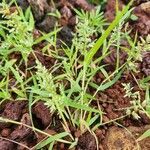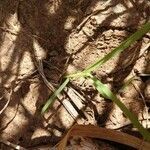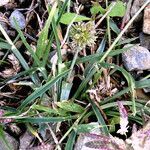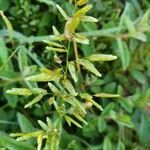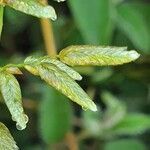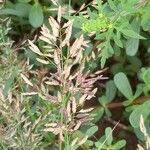Tufted annuals, often aromatic. Culms often geniculate and branched at lower nodes, 12–90 cm high; nodes often purple-black. Leaves with pit-like or warty glands on midnerve and margins; ligule 0.5–1.5 mm long; blade mostly flat, curled, to 20 cm long, 4–8 mm wide with filiform apex, often pilose near ligule. Panicles open or dense, 4–30 cm long, 1.5–10 cm wide; axis, branches and pedicels usually glandular; axis with prominent pulvini; branches entirely spikelet-bearing. Spikelets pedicellate, ovate or oblong to lanceolate, (3–) 6–18 (–30) mm long, 2–4 mm wide, often olivegreen; rachilla almost straight; florets (5–) 12–32 (–60), finally loosely overlapping, with a median depression. Glumes ±equal, boat-shaped (or lower glume narrower), 1.5–2.5 mm long, usually with glandular tubercles on keel. Lemma ovate, sometimes dorsally gibbous, 2–2.5 mm long, obtuse, cartilaginous, 3-nerved, scabrous and tuberculate-glandular on keel, often glossy. Palea: body elliptic; keels strongly curved, ciliate towards apex; flaps to 0.4 mm wide, narrower than body. Stamens 3; anthers 0.3–0.4 mm long. Grain not compressed, globose or broadly ellipsoid, 0.4–0.7 mm long, sometimes striate or reticulate, reddish to dark brown.
Loosely tufted annual to 900 mm high; often geniculate; basal sheaths glabrous, if hairy not densely woolly-hairy; culm often with glands below nodes. Leaf blade to 250 x to 10 mm; margin with or without crateriform glands. Inflorescence dense, side branches usually 40 mm or shorter, spreading to adpressed; lowest branches not whorled; branches and pedicels stout, crateriform glands present. Spikelet 3-20 x 1.5-4.0 mm, narrowly ovate to narrowly oblong, rachilla persistent to sub-persistent; lemmas and/or paleas breaking up from base upwards; glumes subequal, reaching to 3/4 up lemma above; crateriform glands often on keels; lowest lemma 1.7-2.8 mm long, narrowly to broadly obtuse in profile, keeled, keel often with crateriform glands, lateral nerves distinct; palea keels entire, scabrid, persistent, margins wide apart and not reaching apex, narrowing from base to apex between keels and margins; anthers 3, 0.2-0.3 mm long; caryopsis subglobose.
Annual. Culms rather robust, 30–90 cm tall, 3–5 mm in diam., erect or geniculate at base, 3–5-noded, a line of glands below each node. Leaf sheaths with glands along veins, along summit with tubercle hairs; ligules a line of hairs, ca. 0.5 mm; leaf blades flat, glabrous, 6–20 × 0.2–0.6 cm, along midvein and margin glandular. Panicle oblong or pyramidal, 5–20 cm; branch usually solitary, ascending; branchlet glandular. Spikelets dark green, gray-green or yellowish white, compressed, oblong or ovate-oblong, 5–20 × 2–3 mm, 10–40-flowered. Glumes subequal or lower glume slightly shorter, 1-veined, upper glume 1–3-veined, along middle vein glandular. Lemmas chartaceous, broadly ovate-oblong, conspicuously 3-veined, along middle vein glandular, lower lemma 2.2–2.8 mm. Palea persistent; oblanceolate, apex rounded, 1.2–1.6 mm, along keels ciliolate. Stamens 3; anthers ca. 0.5 mm. Caryopsis oblong, ca. 0.5 mm in diam. Fl. and fr. Jul–Oct. 2n = 40.
Spikelets 3–20 × 2–4 mm, narrowly ovate to narrowly oblong, rarely linear, laterally compressed, 5–60-flowered, the lemmas disarticulating from below upwards, the rhachilla persistent or breaking off above the glumes before all the lemmas have fallen; glumes subequal, 1.5–2.2 mm long, reaching to 3/4 or more the way along the adjacent lemmas, keeled, lanceolate to narrowly ovate in profile, often with one or two crateriform glands on the keel, subacute or acute at the apex; lemmas (1.7)2–2.8 mm long, keeled, ovate to elliptic in profile, chartaceous with distinct lateral nerves, diverging from the rhachilla at c. 45°, those in opposite rows not imbricate, the rhachilla just visible between them, pallid yellowish-green to leaden-grey, often with crateriform glands on the keel, obtuse at the apex; palea persistent, glabrous on the flanks, the keels slender, wingless, scabrid; anthers 3, 0.3–0.4 mm long.
Loosely tufted, often geniculate annual, up to 900 mm high; basal sheaths glabrous, if hairy, then not densely woolly-hairy. Leaf blade up to 250 x 10 mm; ligule a fringe of hairs. Inflorescence a panicle, side branches usually 40 mm or shorter, spreading to appressed near apex of inflorescence, branches and pedicels stout. Spikelets 3-20 x 1.5-4.0 mm, narrowly ovate to narrowly oblong, laterally compressed; rachilla persistent, lemmas and/or paleas breaking up from base upwards; glumes shorter than spikelet, 1-nerved. Florets many; lemma narrowly to broadly obtuse in profile, 1.7-2.8 mm long, entire, 3-nerved; palea keels entire, scabrid; anthers 3, 0.2-0.3 mm long. Flowering time Oct.-June.
Annual; up to 0.9 m high; loosely tufted; often geniculate. Culms with basal sheaths glabrous; if hairy; not densely woolly hairy. Leaf blades up to 250 x 10 mm. Flowers: panicle with side branches usually < 40 mm long; spreading to appressed near apex; branches and pedicels stout; spikelets 3-20 x 1.5-4.0 mm; spikelets narrowly ovate to narrowly oblong; rachilla persistent; lemmas and/or paleae breaking up from base upwards; lemmas narrowly to broadly obtuse in profile; 1.7-2.8 mm long; palea keels entire; scabrid; anthers 3; 0.2-0.3 mm long; caryopsis subglobose.
Loosely caespitose annual; culms up to 90 cm tall, erect or ascending, branched or unbranched, glabrous at the nodes, often with a ring of coalescent glands below the nodes; leaf sheaths glabrous, with or without scattered glandular pits; ligule a line of hairs; leaf lamina 4–15 cm × 2.5–8 mm, linear, flat, glabrous, usually with crateriform glands along the margins.
An annual grass. It forms tufts. It grows to 60 cm high. It has an unpleasant smell. The leaf blades are 8 mm wide. They have small dark glands along the edge. The flower panicle is narrow. It is 5-20 cm long. There is a dark ring of glands on the axis below the lower branches of the flower. The spikelets are narrow and 6-18 mm long. There are 10-30 flowers.
Panicle 4–30 cm long, ovate to oblong, fairly dense, contracted, stiffly branched, the spikelets evenly distributed on pedicels 1.5–2.5 mm long, these and the branchlets with scattered crateriform glands, the primary branches not in whorls, terminating in a fertile spikelet, glabrous or pubescent in the axils.
Annual to 90 cm. Leaves linear-lanceolate, basal sheaths sometimes hairy. Spikelets in a narrow panicle with side branches longer than 40 mm, spikelets 3-20 x 2-4 mm, lemma obtuse.
Caryopsis 0.4–0.6 mm long, usually subrotund, rarely oblong.
